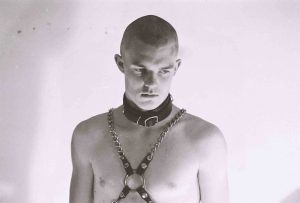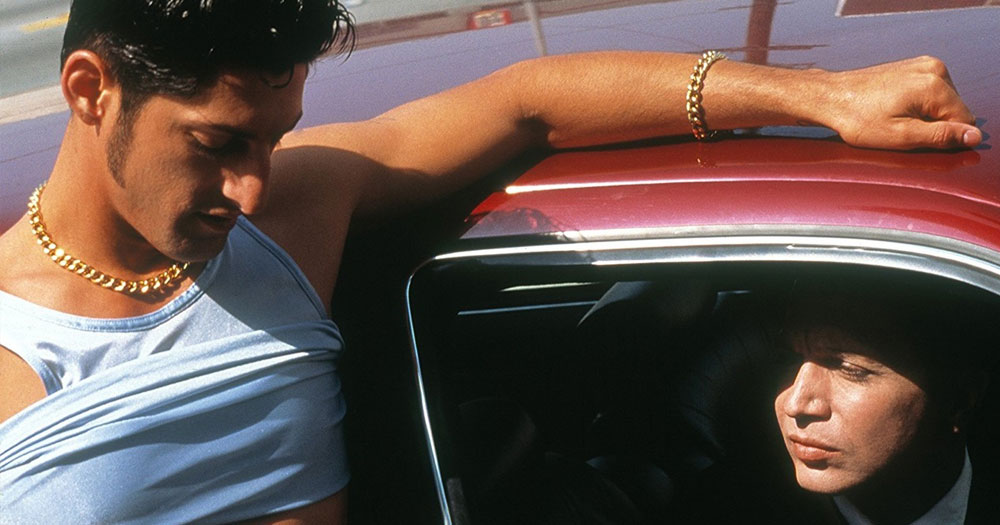Alan Kelly celebrates the the provocative genius of filmmaker and artist Bruce LaBruce.
Like most people my age, my interest in all-things-forbidden started in my early teens following a late-night viewing of Russell T Davies’ groundbreaking UK television show Queer As Folk. It was the first programme broadcast in Britain (Europe?) that offered viewers a realistic depiction of gay male lives and sex. Davies had engaged with what the viewing public largely considered taboo and sexually explicit and enraged readers of The Daily Mail in the process. He got people talking candidly about the realities of sexual minorities on an international scale (there was a successful American reboot too).
The point I’m trying to make is that our culture has always understood that monstrosity is an essential facet of human existence – we’ve become used to the unbridled sadism on the news – but sex is another thing entirely.
As one fan pointed out in the documentary on Bruce LaBruce, The Advocate For Fagdom, sex still has that “dirty word” connotation and, culturally, we are more tolerant and accepting of violence. Sexuality remains an element in (some) of our lives that we’re actively encouraged to be ashamed of, to fear and never to celebrate provocatively. Bruce LaBruce has established that the controversial components of sexual difference are worth embracing.
Operating on the fringes of queer horror and art, underground writer/director LaBruce is the king of pop art, porn and political rhetoric. The enfant terrible and cultural anti-hero has been shocking, turning on (or off), and provoking audiences with his hellacious hedonism and artistic deviance since emerging as a cult figure in filmmaking in the alt-art circuit back in the 1980’s.

Taking a punkish, anti-assimilation stance, in his films left-field concepts collide with kink and a Warhol-esque sensibility that tackles notions of masculine identity, sex, the cult of homo-normativity and queer conservative values. The prolific artist’s work in direct opposition to traditional cinematic style, artistic form and sexual conformity with the influences of Andy Warhol and Jean Genet permeating the narratives of his blood-slicked skin flicks.
Hailing from Ontario, Canada, the once quiet farm-boy was by his own admission introverted and bookish in his earlier years. By adopting the moniker (after a 1930’s arsonist) ‘Bruce LaBruce’, he was able to develop a more courageous (and outrageous) identity, a personal armour that would help him generate an amazing body of work and become a trailblazer in both politics and art.
Alongside his partner-in-crime, G.B Jones, he put together and distributed J.D.s (Juvenile Delinquents) – an influential zine that made a considerable impact across the multiple-platforms of Queercore, an alternative-to-punk-punk-queer movement with a grunge philosophy and DIY-aesthetic that incorporated music, sexual provocation and art-terrorism. Nothing was sacred in LaBruce’s cinematic output and with all sexual fetishes’ and the humanity behind the amputee porn, the BDSM, gang-bangs, zombie-sex and myriad other paraphilias placed under his spotlight.

There are voices in pop culture deemed transgressive by the mainstream for their investigations into provocative subject matter, those who transcend what is morally-palatable and regarded as safe, those who navigate fearlessly at the at the outer reaches of the entertainment spectrum: Kathy Acker’s found-art approach with the controversial Blood And Guts In High School. Lydia Lunch with Paradoxia and The Gun Is Loaded and Virginie Despentes with their aggressive feminist proselytising Baise Moi.
Gus Van Sant and Gregg Arraki examined the psychological fall-out within feral teen subcultures of sex work, addiction and abuse from a male perspective. Gasper Noe’s searing Irreversible addressed rape culture and the futility of revenge with a reverse-narrative storytelling device and David Cronenberg has utilised body-horror staples with a grotesque and thought-provoking elegance for decades.
The difference between Bruce and his contemporaries is that like John Waters, he injects his pornographic tableaus with a sense of fun and lots of black comedy. Let’s look at some of his essential works.
HUSTLER WHITE
Immersive, and arguably a tad corrupt, is Hustler White. If you happen to see a Dennis Cooper-like character strutting down Hollywood Boulevard in white pants and a tight wife-beater, the odds are he is a hustler and on-the-beat. Madonna’s ex-boyfriend, a 20+ gang-bang with a Twink-ish guy, male hookers and hustlers and Johns all combine in sunny, underworld, Los Angeles.
THE MISANDRISTS
Filmmakers know that government funding is a slow-process, restricts creative control and could sway a film’s final edit to its detriment, so The Misandrists is LaBruce’s crowd-funded response.
The bonkers tale concerns a militant group of feminist sexual revolutionaries aiming to build a murder-happy matriarchal order to subjugate men. The director worked with Amard Bird, a radical Berlin-based production company and an almost entirely female-crew for his anarchist exploitation film.
OTTO: OR UP WITH DEAD PEOPLE
George (Dawn Of The Dead) Romero meets Michele (Cemetary Man) Soavi in LaBruce’s anti-consumerist, existential slice of zombified Gornography! In Otto: Or Up With Dead People, the creepy absurdist humour and avant-garde visuals are reminiscent of Mario Bava and Lucio Fulci at their most outlandishly bloody and baroque.
Exquisite corpse Otto is a love-struck zombie who only wants to find and (perhaps?) eat his boyfriend, with a little help from Medea Yarn, a porn filmmaker whose specialist subjects are of course necrophilia, pornography and reanimation.
Otto was a reaction to the sanitised, male-dominated and class-oriented projection of the ideal gay male aesthetic/gay men as a commodity and those of us who don’t fit into this body-image/class category. It’s to die for!
THE PORN DIARIES: HOW TO SUCCEED IN HARDCORE WITHOUT REALLY TRYING
A pornologue/memoir, it’s a warts and all account of the schlockmeisters quest through the world of underground sleaze and debauchery. The coffee-table tome would be an ideal ice-breaker at family functions or help you get past that initial-awkward-conversation-phase with a new work colleague. You might make a new friend impressed by your in-depth knowledge of alternative sexual culture. Or you might get a restraining order.
For more musings on outsider artists and filmmakers, make sure to follow Alan Kelly on social media.
© 2022 GCN (Gay Community News). All rights reserved.
Support GCN
GCN is a free, vital resource for Ireland’s LGBTQ+ community since 1988.
GCN is a trading name of National LGBT Federation CLG, a registered charity - Charity Number: 20034580.
GCN relies on the generous support of the community and allies to sustain the crucial work that we do. Producing GCN is costly, and, in an industry which has been hugely impacted by rising costs, we need your support to help sustain and grow this vital resource.
Supporting GCN for as little as €1.99 per month will help us continue our work as Ireland’s free, independent LGBTQ+ media.
